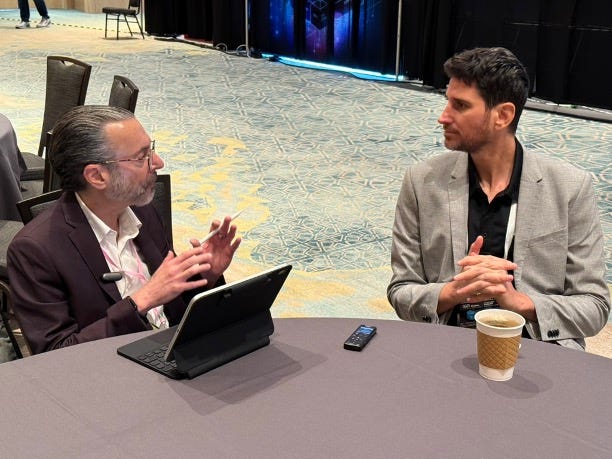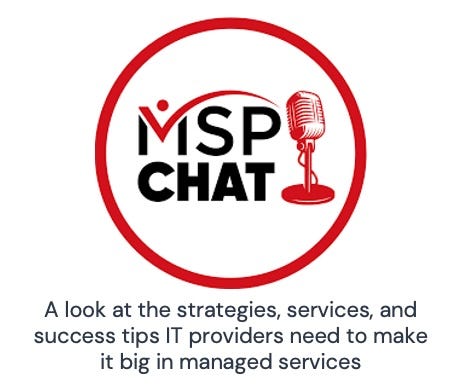Bonus Post: As I Was Just Going to Say…
I’m back after a six-week absence with belated thoughts about ConnectWise, Coro, Sherweb, and SIEM solutions. Plus: some deeply inadequate words about the late, great Alan Weinberger.
Back in 1857 (stick with me on this), Oliver Wendell Holmes began the latest installment of his Atlantic Monthly column with these words:
“I was just going to say, when I was interrupted, that one of the many ways of classifying minds is under the heads of arithmetical and algebraical intellects.”
Not immediately obvious, but this is actually funny stuff. Holmes was picking things up right where he’d left them in his last post—in 1832. For reasons the author himself discusses elsewhere, the “interruption” he’s alluding to was 25 years long.
I, on the other hand, have been silent a mere six weeks, for sudden, difficult, and intensely personal reasons I won’t get into here, except to note that they’ve left me with a lot of stuff I was just going to say when I was interrupted, and which I can finally, belatedly get into now. I’ll try to keep it short(ish).
It’s all about scale at ConnectWise
Time flies if you’re a ConnectWise watcher. Can it really have been nine months since Manny Rivelo stepped in as the storied vendor’s third-ever CEO?
You’ve read multiple times here since then about the investments Rivelo has made in what he considers the company’s most important assets—its platform, ecosystem, and community—as well as the pricing changes he and others have hinted at several times in recent months.
What you haven’t read here is the perhaps obvious yet still clarifying theme unifying those and other moves, mostly because it wasn’t until last month’s IT Nation Secure event in Orlando that Rivelo laid it out plainly for me. ConnectWise, we know from reporting here and elsewhere, has been somewhere in the neighborhood of a $1 billion top line for a while. Rivelo’s assignment when he joined the company was to roar past that milestone as far and fast as possible.
“That’s what our board was seeking,” he says. “How do we now scale to multiple billions of dollars over time?”
Rivelo has led and studied enough companies through the years to know that few things make realizing a goal like that harder than complexity. Big, fast-growing software makers like Salesforce, ServiceNow, and others ConnectWise models itself after make buying and deploying software very, very easy.
“You don’t scale into billions or tens of billions of dollars, or some of them hundreds of billions of dollars, without having that,” Rivelo (pictured) says.
ConnectWise and its private equity owner, Thoma Bravo, have been aware of that fact since well before Rivelo’s arrival. Hence Asio, the next-generation application platform ConnectWise has been working on for years, and which took a significant step forward at last month’s conference with the limited initial release of a new Asio-based edition of ConnectWise PSA.
As we’ve discussed before, Asio’s designed to provide a shared, Apple-esque, platform-as-a-service foundation for software from ConnectWise and its ecosystem partners. From the get-go, however, its other, equally important mission has been to fuel product-led growth by giving MSPs a single, seamless, fully integrated place to research, test, and implement ConnectWise software.
“Ultimately, where we want to be is they can come to our website, they can look at one or more of the products, they can set up a trial, we have fully automated onboarding, and they can start to deploy,” says Jeff Bishop, executive vice president of product management for Asio and ConnectWise’s RMM and PSA solutions.
Deploy then procure, of course, which is where ConnectWise Pro, the new pricing plan we’ve known was coming in some form since last November and which we got an initial look at during IT Nation Secure, comes in. The package includes Asio-based RMM, PSA, quoting, remote access, and RPA applications, plus the security and backup dashboards ConnectWise has been including with Asio free of charge since March, with add-ons to come for security, NOC services, and more. Pricing, which ConnectWise will disclose later this month, will be both “very simple” and “very competitive,” according to Bishop.
“This is going to end up being one of those things where you buy one unit, it’s going to end up being, say, sub-$10,” he explains. “Depending on your volume, you’re going to see this thing go down to a couple of bucks per endpoint or user.”
Buyers will be free to choose between per endpoint and per user rates, but those will be the only two ways rates are calculated, versus the roughly seven in effect today. “That creates a lot of transparency for our partners,” Rivelo says. “They know what their COGs are from us and then whatever margin they place on top of that.”
There’s more coming, too. It’ll take a while, but ConnectWise will eventually boil the 47 products it has now down to eight core applications, all of which will be procurable with Pro-like simplicity.
“We’re definitely going to continue to invest in how we scale the company to make it easier to transact,” Rivelo says.
Which is to be expected, because “simplicity + scale = sales” is the unspoken equation underpinning much of what Rivelo’s done since becoming CEO and plans to do going forward. Bishop, without providing details, suggests we’ll see more of that formula come to life at ConnectWise’s next big conference this fall.
“The November IT Nation Connect is going to be a lot of fun,” he says.
The great SIEM schism
Platforms. Pricing. You kind of expect ConnectWise and companies like it to have firm thoughts about topics like that. I didn’t realize until recently, though, how opinionated many vendors are about SIEM solutions too.
The debate, to be more precise, concerns the relative merits of SIEM solutions on the one hand and XDR/MDR solutions on the other. Huntress, Kaseya, and ConnectWise don’t see this as an either-or question. All three companies have offered some combination of MDR and XDR for a while and SIEM services as well since April (in the case of Huntress and Kaseya) and June (in the case of ConnectWise).
“Some people want to collect all the information that a SIEM provides,” Rivelo explains, and ConnectWise aims to give those mostly larger, more sophisticated buyers exactly what they seek.
Which in most cases is not what they need, according to multiple vendors I’ve spoken with lately, at least if they focus on SMBs. “You can go deploy a SIEM,” says Dor Eisner (pictured), CEO of generously capitalized detection and response specialist Guardz. “You can also take a Ferrari and go around the house. It won’t take you far. That’s my analogy about SIEM. You as an MSP don’t need the Ferrari to drive cybersecurity for a small business organization.”
What’s more, you probably can’t afford either a Ferrari or a SIEM solution, adds Brian Downey, VP of product management at Barracuda Networks, and wouldn’t know what to do with either one if you could.
“Security’s all about consolidating information, and that’s where SIEM is very powerful,” Downey says. How are you going to act on that data once you’ve centralized it though?
“MSPs need solutions not tools, and SIEM in many cases is a tool,” Downey says, which is why Barracuda opted to purchase an XDR vendor rather than a SIEM vendor four years ago. A solution uses SIEM data as a basis for action.
N-able had the same thought in mind when it bought MDR/XDR vendor Adlumin last year. SIEMs can help you detect and assess a threat, but that’s only part of the equation, notes president and CEO John Pagliuca during a recent conversation on MSP Chat, the podcast I co-host.
“The full equation is the response and the remediation, and that’s what the Adlumin solution does,” he says.
N-able, no doubt, would love that assertion to close the book on the SIEM debate. Given the degree to which SIEM turns out to be kind of a Rorschach test for security vendors, though, I doubt it will.
Coro keeps it simple
Coro, like ConnectWise, is a big believer in the tight bond between simplicity and success.
“Most of our partners out there, whether they’re hybrids that are still doing resale plus services or full-blown MSPs, want simple,” says Joe Sykora, who became the security vendor’s senior vice president and general manager for the Americas in March.
Coro’s platform, which combines 15 security technologies (including, since May, security awareness training) on one interface, is the core of the company’s strategy for giving them simple. Most MSPs assemble and integrate a security stack themselves, explains Sykora (pictured), a 29-year industry veteran with senior-level stints at Fortinet, Bitdefender, and Proofpoint under his belt. Coro does that work for them.
“We just make it simple,” he says.
There’s presumably at least some connection between that simplicity and the 2,670% growth Coro says it’s recorded across the last three years, along with its position toward the top of Deloitte’s latest Technology Fast 500 list. Sykora, like his EMEA counterpart Piers Morgan, is responsible for sustaining that momentum by scaling the vendor’s roughly 1,000-member channel rapidly.
“There are eighty to a hundred thousand MSPs globally out there today, and we’ve barely touched many,” Sykora notes. “We are definitely out to recruit new partners.”
The partner program Coro rolled out last month is an important step in that process. Called Compass, it replaces a predecessor that Sykora calls “a little complex.” Compass, by contrast, has simple rules and just two tiers, one for active and engaged partners and another for everyone else.
“I don’t get into the four- and five-tier precious metal type stuff,” Sykora observes.
Compass has a deeper MDF budget and more marketing resources than the program it replaces too, he adds, and stronger deal registration benefits, including a one-time 15% upfront discount.
“It’s one of the highest in the industry, because I want to give all of our partners predictability with their margins,” Sykora explains.
Other changes Sykora has implemented since joining Coro include rebuilding the channel organization around dedicated territory managers backed by account management, inside sales, and sales engineering teams, as well as eliminating direct sales to end users.
“We are 100% channel,” Sykora says.
The distribution partnerships Coro will soon announce, a first for the company, are another element in the vendor’s campaign to establish itself as the leader among single-company, single-platform security vendors like Cynet, Guardz, and Judy Security.
“There is no clearly defined go-to in the space,” Sykora says. “That’s really one of the reasons why I was brought in, to help create that awareness.”
Sherweb’s value-added marketplace plan
Will Sherweb be among Coro’s future distribution partners? I didn’t ask and Sykora wouldn’t have said if I had, but you could imagine Coro feeling a little left out if Sherweb doesn’t invite them onto its line card at some point. After all, the cloud marketplace has added security solutions from usecure, DefenseX, IRONSCALES, HacWare, ConnectSecure, and Nord Security to its catalog since the start of April alone, with Keepit and Check Point not far behind.
In fact, only one of the many additions to Sherweb’s marketplace this year (RPA vendor Rewst) has not been in cyber. And no, that’s not a coincidence. Sherweb is placing a big strategic bet on security.
“We see the growth potential,” says Roddy Bergeron, a cybersecurity technical fellow at the company.
It also sees security as a path forward through a packed, diverse and fast-growing competitive scene. Per Canalys, vendors—along with their partners and end users—have six different routes to market available to them now plus an accompanying set of marketplace development platforms:
Sherweb’s strategy for standing out in that crowded field is to redefine itself as a cross between a multi-specialty cloud marketplace like Pax8 and a security-focused, value-added distributor like Exclusive Networks. Bergeron, who was CISO at Louisiana-based MSP Enterprise Data Concepts for two years prior to joining Sherweb, has played an instrumental role in that effort, initially by comparing the company’s security portfolio to controls defined in the CIS framework.
“We identified very early on that there were some gaps in our security offerings,” he says. “Especially as security becomes more complex, we can’t just offer email security or endpoint protection or just the basics anymore. We have to start grabbing more advanced tools and bringing vendors in who can help with that.”
Which is exactly what Sherweb’s been doing in recent months through all those marketplace additions, each of which, according to Bergeron, was carefully selected.
“We’re trying to do a more curated list of programs or vendors, the ones that we think are making big impacts in the space, and then help drive our partners to those,” he says.
That, however, is the “marketplace” part of what I’ll call Sherweb’s value-added marketplace vision. The value-added part, in addition to outsourced help desk and NOC services and free resources like Sherweb’s Microsoft 365 security assessment tool, emphasizes partner education. Bergeron learned the hard way as an MSP that talking with SMBs about security products rarely ends well.
“No one cares what kind of firewall you put it in place,” he says. “No one really cares about the antivirus on their computer.” They do care, however, about the damage a ransomware attack or PII leak can have on their top and bottom lines, which is why Bergeron had much greater success with clients when he started structuring conversations around business risk and security strategy.
“Instead of looking like a cost center, we looked like revenue protection,” he says, adding that what had been a 16% close rate rose to something more like 80% as a result. Bergeron and his team are now teaching partners how to drive similar success.
“You have to talk about the outcomes that you bring,” he says. “You have to talk about how you’re protecting revenue. You have to talk about how you’re protecting their reputation. You have to talk about all the other things that matter to their business.”
That said, tools are how MSPs ultimately deliver revenue protection, which makes providing a complete selection of them an ongoing priority for Sherweb. According to Bergeron, more solutions in more categories will appear on the company’s marketplace over the months ahead.
“We’ve got some pretty cool SASE products coming down the pipeline,” he says, as well as some risk-based vulnerability management systems. Watch this space for details when they arrive.
No really, you should listen to my podcast
Sherweb’s security strategy is precisely the kind of thing we get into every week on MSP Chat, the podcast I co-host. Check it out here or wherever you get your podcasts.
Alan Weinberger, R.I.P.
If you knew him at all, I’m guessing you’ve heard by now that ASCII Group founder and chairman Alan Weinberger passed away late last month. If you didn’t know him—which would surprise me a little given that he seemed to have met everyone in the tech industry at some point—you may not fully appreciate why so many people, me among them, are so saddened by the news.
The biggest reason, as many others have noted, is because Weinberger (pictured) was about as warm, generous, and endlessly interesting a person as you’re likely to meet. But I’ll point out a few other things worth noting as well:
The channel, as ConnectWise and TD SYNNEX among many others appreciate, is defined as much as anything by the go-giver spirit of community that animates its members. Weinberger, who founded The ASCII Group when there barely was a channel we’d recognize today, deserves a lot of credit for inventing that culture and nurturing it across more than 40 years.
Weinberger’s biggest motivation in creating The ASCII Group was to help small IT businesses stand up to huge ones through the power of collective action. The rise of PE-based managed services giants, per a story I posted a year ago, only re-doubled Weinberger’s devotion to ensuring that MSPs who prize autonomy over scale can fight much larger competitors on an even playing field.
A little over a fifth of businesses never make it to their first birthday. A little under two thirds never celebrate their tenth. Weinberger’s business is still going strong at age 41. Hard to overstate what an against-the-odds achievement that is under any circumstances and especially in an industry that changes as often and significantly as ours.
One last thing: The team behind The ASCII Group isn’t a large one. It’s a small, very effective, close-knit one that functions (in all the good and, on some days undoubtedly, bad ways) like a family as much as a company, and a hugely important member of that family isn’t there anymore. I’ve experienced what that feels like earlier in my career. It’s hard.
My sincerest condolences, then, to both of Weinberger’s families: the one he made with his wife Lauren and the one he built at The ASCII Group. A memorial page with links to non-profits you can donate to in Weinberger’s memory is located here.
Also worth noting
Buying cloud commerce specialist Apptium is the latest step in TD SYNNEX’s build, buy, and partner strategy for marketplace development.
Speaking of apps, Mac management vendor Addigy now has a whole catalog of pre-built ones for its MSP users to tap into.
Increased AI use by black hats is one reason unique malware detections rose an astonishing 712% quarter over quarter in Q1, according to WatchGuard.
SailPoint’s Data Access Security product has achieved FedRAMP moderate authorization.
Microsoft, with SMBs very much in mind, now offers three-year subscriptions of Microsoft 365 E3 and E5 to its CSP partners.
The new TeamViewer Intelligence platform is designed to help technicians analyze screenshots and error logs, identify best practices, resolve issues faster, and more.
Newcomer OpenMSP has rolled out a set of open source alternatives to pricier name-brand RMM, PSA, and similar tools. Hoping to speak with these folks about their strategy soon.
Further proof that vertical SaaS is hot: legal industry SaaS vendor Clio has spent $1 billion in cash and stock on legal intelligence vendor vLex.
Outsourced IT support vendor Helpt (who you’ve met here before) has introduced an upgraded version of its HelptFlow service offering new remote access options, direct PSA integration, and more.
Spending on subscription print services will be down or flat overall this year, but up in SMB.
Hungry for in-depth guidance on automated marketing with AI? The Channel Marketing Association is serving up two days of virtual content on the topic—free—in two weeks.









